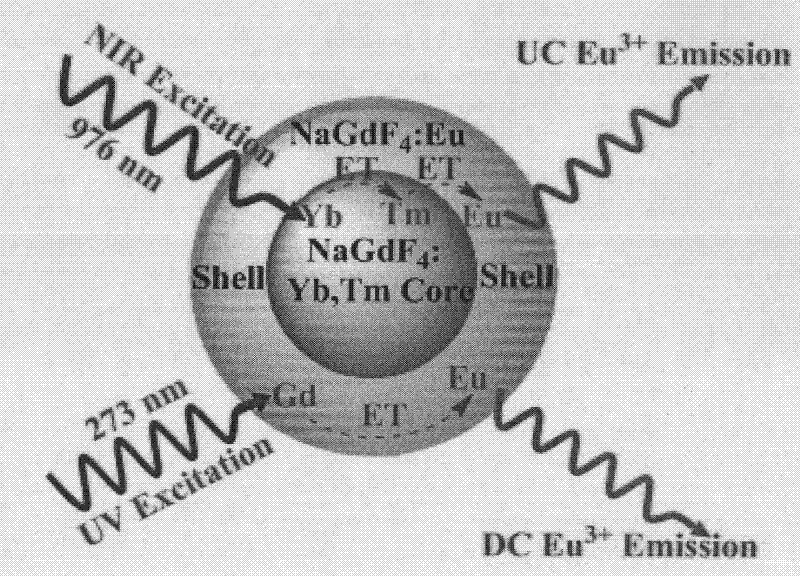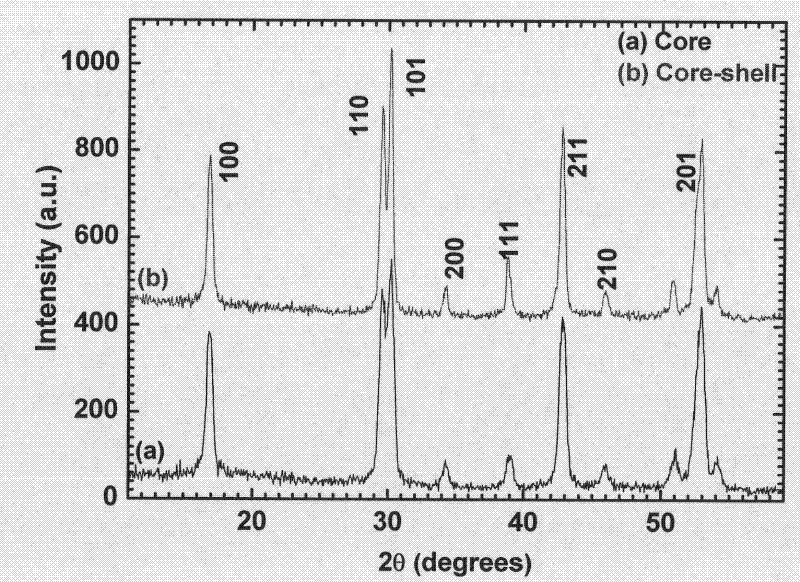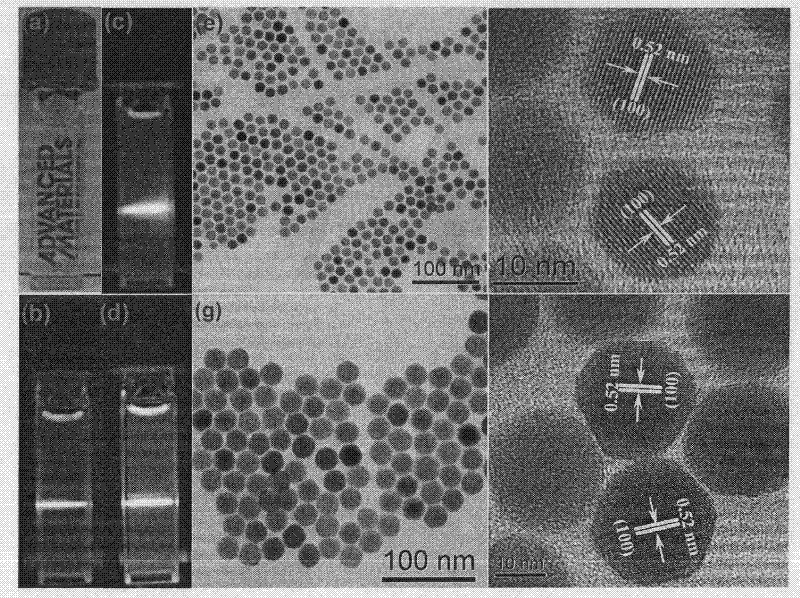NaGdF4 multifunctional fluorescent label nano-material based on europium ion dual-mode luminescence
A technology of fluorescent labeling and nanomaterials, applied in the directions of luminescent materials, chemical instruments and methods, etc., to achieve the effect of simple preparation process, uniform particles and good repeatability
- Summary
- Abstract
- Description
- Claims
- Application Information
AI Technical Summary
Problems solved by technology
Method used
Image
Examples
example 1
[0019] Example 1: (1) NaGdF 4 :18%Yb 3+ , 1%Tm 3+ Preparation of nanocrystalline cores. Weigh 0.151g gadolinium chloride (GdCl 3 .6H 2 O), 0.0019g thulium chloride (TmCl 3 .6H 2 O) and 0.0349g ytterbium chloride (YbCl 3 .6H 2 O) into a 100mL three-necked flask, add 5mL oleic acid and 16mL octadecene, stir to make it evenly mixed. Under the protection of nitrogen flow, the above mixture was heated to 150° C. and kept at this temperature for 90 minutes to completely dissolve the rare earth chloride and obtain a transparent clear solution. After cooling to room temperature, 10 mL of methanol solution in which 0.084 g of ammonium fluoride and 0.084 g of sodium hydroxide were dissolved was added dropwise, stirred and allowed to react at room temperature for 30 minutes. Then the mixed solution was heated to 50° C. and kept for 30 minutes to remove methanol in the reaction system. After the methanol was removed, the reaction system was heated to 300° C. under the protection...
example 2
[0021] Example 2: (1) NaGdF 4 :18%Yb 3+ , 0.5%Tm 3+ Preparation of nanocrystalline cores. Weigh 0.1515g of gadolinium chloride, 0.001g of thulium chloride and 0.0349g of ytterbium chloride into a 100mL three-neck flask, add 5mL of oleic acid and 16mL of octadecene, and stir to make them evenly mixed. Under the protection of nitrogen flow, the above mixture was heated to 150°C, and kept at this temperature for 90 minutes to completely dissolve the rare earth chloride and obtain a transparent clear solution. After cooling to room temperature, add 0.084g of ammonium fluoride and 0.084g of sodium hydroxide in methanol solution 10mL, stirred and allowed to react at room temperature for 30 minutes, the mixed solution was heated to 50°C and kept for 30 minutes to remove methanol in the reaction system. After the methanol was removed, the reaction system was heated to 300° C. under the protection of nitrogen flow, kept for 60 minutes, then stopped heating, and allowed to cool down ...
example 3
[0023] Example 3: (1) NaGdF 4 :18%Yb 3+ , 0.3%Tm 3+ Preparation of nanocrystalline cores. Weigh 0.1518g of gadolinium chloride, 0.0006g of thulium chloride and 0.0349g of ytterbium chloride into a 100mL three-necked flask, add 5mL of oleic acid and 16mL of octadecene, and stir to mix them evenly. Under the protection of nitrogen flow, the above mixture was heated to 150° C. and kept at this temperature for 90 minutes to completely dissolve the rare earth chloride and obtain a transparent clear solution. After cooling to room temperature, 10 mL of methanol solution in which 0.084 g of ammonium fluoride and 0.084 g of sodium hydroxide were dissolved was added dropwise, stirred and allowed to react at room temperature for 30 minutes. Then the mixed solution was heated to 50° C. and kept for 30 minutes to remove methanol in the reaction system. After the methanol was removed, the reaction system was heated to 300° C. under the protection of nitrogen flow, kept for 60 minutes, ...
PUM
 Login to View More
Login to View More Abstract
Description
Claims
Application Information
 Login to View More
Login to View More - R&D
- Intellectual Property
- Life Sciences
- Materials
- Tech Scout
- Unparalleled Data Quality
- Higher Quality Content
- 60% Fewer Hallucinations
Browse by: Latest US Patents, China's latest patents, Technical Efficacy Thesaurus, Application Domain, Technology Topic, Popular Technical Reports.
© 2025 PatSnap. All rights reserved.Legal|Privacy policy|Modern Slavery Act Transparency Statement|Sitemap|About US| Contact US: help@patsnap.com



